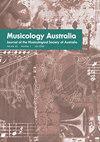The Adaptation of Violin Playing by Indigenous People in Early Twentieth-Century Western Australia and New South Wales
IF 0.4
0 MUSIC
引用次数: 0
Abstract
Abstract This article will use the European violin as a lens through which to reinterpret interactions between Aboriginal people and Europeans in twentieth-century Australia. The violin is a particularly well-respected instrument within the western art music tradition. Accordingly, the Europeans took the Indigenous embrace of the violin as evidence of successful assimilation policies and the acquisition of civility. However, the diverse and adaptable sound of the violin, combined with its construction from natural materials, aligned with Aboriginal people’s traditional and collaborative experience of music. This allowed the violin to act as a powerful means of cultural continuation and expression that was encouraged, not forbidden. The ability to adapt in the face of cultural genocide has ensured the survival of Aboriginal people and their traditions over the years since the colonists arrived and it is important to understand how Aboriginal people reacted. The article aims to contribute not only to a new understanding of the way Aboriginal people have responded to the violin, but also to how it has been understood within histories of Australia and colonization.20世纪初澳大利亚西部和新南威尔士州原住民对小提琴演奏的改编
摘要本文将以欧洲小提琴为镜头,重新解读20世纪澳大利亚原住民与欧洲人之间的互动。小提琴在西方艺术音乐传统中是一种特别受人尊敬的乐器。因此,欧洲人将土著人对小提琴的拥抱视为成功的同化政策和文明获取的证据。然而,小提琴的多样性和适应性,加上其由自然材料制成的结构,与原住民的传统和合作音乐体验相一致。这使小提琴成为一种强有力的文化延续和表达手段,而这种文化延续和表现是受鼓励的,而不是被禁止的。自殖民者到来以来,面对文化种族灭绝的适应能力确保了原住民及其传统的生存,了解原住民的反应很重要。这篇文章不仅旨在帮助人们重新理解原住民对小提琴的反应方式,还旨在帮助人们在澳大利亚和殖民历史中如何理解小提琴。
本文章由计算机程序翻译,如有差异,请以英文原文为准。
求助全文
约1分钟内获得全文
求助全文

 求助内容:
求助内容: 应助结果提醒方式:
应助结果提醒方式:


